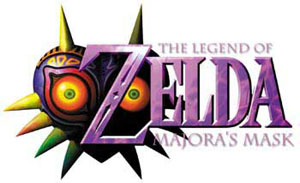
 |
|
The Legend of Zelda series has always stood head and shoulders above standard games, mixing constant innovation with a basic formula that has charmed gamers for over 13 years. No matter which system or game, the series has provided a polished experience that stayed far ahead of the competition. Now, just as the first Zelda broke new ground with battery saves and Ocarina of Time brought adventuring fully into 3-D, Majora's Mask uses time to integrate the player into the game world as almost no title ever has.
Instead of familiar Hyrule, this new Zelda finds Link drawn into the land of Termina, and the story begins as he is robbed and turned into a Deku Scrub by Skull Kid. Merely a mischevous boy until he stole Majora's Mask, Skull Kid is now completely controlled by its wicked power. After finding his way to Clock Town, Link learns that the moon has been summoned to crash into the world in a mere 72 hours. Now he must find his ocarina again, regain his true form, and somehow keep the sky from falling. While virtually every game features some kind of impending doom, Majora's Mask does not conveniently wait for you to intervene. If you are not able to retrieve your ocarina in 72 hours, you remain transformed as a Deku Scrub and are forced back to when you first entered town. Should you succeed, Link will learn the Song of Time, allowing him to warp back to the beginning of the three-day period, slow the passage of time by half, or progress it in 6 hour blocks.
Playing the Song of Time and going back to the beginning is the only way to permanently save your game. Link will also find owl statues that can be used to save and quit, but it is a temporary save disappears when the file is resumed. All major items are kept when traveling back through time, but disposables such as arrows and bombs are lost. While money is also lost, a bank is available from the start that keeps your money safe when deposited. To help keep track of time, a sundial is located at the bottom of the screen – but a more dramatic indicator can be had by simply looking into the sky. The dark, sneering moon grows steadily closer, eventually filling the horizon and causing the ground to shake under its ominous pressure. As the days progress, the citizens of Termina go about their daily lives, eventually beginning to evacuate as the moon threatens to fall. As you gain control over time, you can catch specific people doing specific things which may aid your quest. Stopping a robbery allows a store to stock new items, while the Stock Pot Inn may house different guests depending on the day. Luckily, a notebook can be found which keeps track of people, their routines, and what they need help with.
This innovative time system succeeds beautifully in meshing plot and gameplay, with the frustration of being on a deadline kept to a minimum. While most progress within towns and dungeons resets if you warp back in time, good planning on the player's part can easily prevent this. Think like the hero – if you had 12 hours left and were just entering a massive dungeon, would you risk having to warp back midway through or make the needed preparations to explore in one trip? The dungeons are indeed massive, and while they may be fewer in number than those in traditional Zelda games, the use of the Expansion Pak has allowed for unprecedented room size. Dungeons are no longer a series of small chambers, but now consist of realistic multi-level caverns, a feature that also figures prominently into puzzle and enemy placement. No game has yet to compare with Ocarina of Time's legendary dungeons, but Majora's Mask succeeds in taking the design in a new direction while maintaining the same level of quality. The game also benefits graphically from mandatory use of the Expansion Pak, with virtually zero pop-up and an extremely long field of view. Texture quality is adequate and is more than made up for by the impressive world design and architecture. The famed overworld theme returns in full force, joined by a quality soundtrack throughout, especially the moody dungeon themes. And this time, the fairy is actually charming instead of irritating.
Though the control scheme and basic mechanics are kept intact from Ocarina of Time, the system of masks has been expanded from novelty feature to main gameplay element. A total of 24 masks are available, with effects that range from completely transforming Link to helping him find fairies or allowing him to cause bomb-like explosions. The central masks – Deku, Goron, and Zora – allow Link a host of new movement and offensive abilities that are necessary to complete the dungeons and participate in certain minigames. It is worth noting that Shigeru Miyamoto, creator and longtime director of the Zelda series, played only a small role in the creation of Majora's Mask. His assistants at Nintendo, led by Eiji Aonuma, have taken what was considered Miyamoto's greatest creation and made a worthy sequel in a comparatively paltry two years' time. With a bolder sense of design and a much edgier mood than its N64 predecessor, Majora's Mask perfectly fills the role of being a unique and entertaining installment in what may now be gaming's most accomplished franchise. Review by Ed McGlothlin, GIA |
|
|||||||||||||||||||||||||||||||||||||||||||||||||





